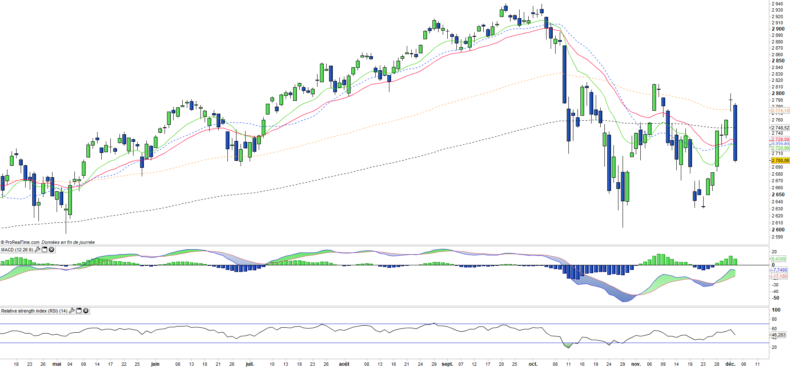SPDR S&P 500 (SPY) - 05/12/2018
Short Term strategy: Negative (10%) / Trend -
Long erm strategy: Neutral (50%) / Trend -
Characteristics of the ETF
The SPY ETF (SPDR) created in 01/1993 replicates the S & P 500 index, which is composed of the 500 main US stocks representative of the main sectors, while the stocks are selected according to the size of their market capitalization.
The ETF fees are quite low at 0.0945% and the AUM is $ 268bn. Replication is direct (physical) and there is a dividend distribution policy on a quarterly basis.
Alternative ETFs: AUM5 (Amundi in Euro), SP5 (Lyxor in Euro), IVV (iShares, in USD)
Index & components
The top 10 stocks of the S & P500 include five major technology stocks (Apple, Amazon, Microsoft, Alphabet and Facebook), but also larger, more classic and iconic American companies such as JP Morgan or Exxon Mobil.
The main benefit of this index is its depth, which allows it to be a good proxy for the US economy, with a sector weighting that favors the growth sectors a little more, just like the technology stocks that represent about 20% of the weighting. Financials account for just under 13% of the index, and energy values of 6% are well balanced by defensive sectors such as health (about 15%) and consumer discretionary (10%).
The index has benefited from a strong momentum since the election of D. Trump, at the end of 2016, while alongside the technology that remains the engine of the US market, new sectors have joined the trend, however a correction is now underway on the index because of fears of trade war and a return of inflation following the program of lower taxes for US businesses and households that should have a positive impact on growth, while announced deregulation on shale oil and banks could also benefit these sectors. However the multiples of the S & P 500 are currently quite high, even after the correction, at around 17x results at 12 months, which is in the middle of the range (historically between 15 and 20x) but near the end of the cycle, even if it must American economy growth estimated at around 3,5% in 2018.
The whole question is now about the duration of the US cycle in a context of rising rates which is still progressive for the moment while the level of margins is at its highest level and appears to have lost much upside potential, even though the consensus again is for a sustained growth of earnings in 2019.
Latest developments
After an increase of 19.4% in 2017 fairly linear, the index has only progressed by about 1% since the beginning of the year but with an increasingly chaotic course linked to fears aroused by the protectionist policy of D. Trump, the trade war with China and the prospect of the end of the growth cycle of the US economy that is manifested by an ever weaker spread between the 2-year and 10-year rates curve, after a sharp decline in long rates since a few weeks.
The instability caused by the tweets of D. Trump, exacerbates the fears of investors and should trigger a recession in the second half of 2019, while the weakness of the US economy begins to feel as shown by the recent weak construction datas.
Weekly data
The weekly chart shows a clear failure on the resistance of 2800 pts which translates into an immediate bearish reversal just one day after the WE announcements. This is a counter-foot and the reason is the weakness of the rebound on Monday despite positive announcements. A return on the 2600 pts level is now the preferred scenario, while the bearish breakout of this support becomes a probable scenario.
Daily data
On the daily chart, we can see the major pullback achieved on the 2800 pts level in the form of a powerful bearish candlestick that comes not only fill the open gap at the beginning of the week but also cross both the short term and long term moving averages. The size of the candlestick shows the risk off mood of the market while the trend became bearish. The sellers seem to have taken over again.
ETF Objective
SPY is an ETF, listed in USD, which seeks to replicate the S&P500 index (506 US companies)
Characteristics
| Inception date | 22/01/1993 |
| Expense ratio | 0.09% |
| Benchmark | S&P 500 |
| Issuer | SPDR |
| Ticker | SPY |
| ISIN | US78462F1030 |
| Currency | $ |
| Exchange | NYSE Arca |
| UCITS | No |
| Assets Under Management | 268 588 M$ |
| Replication Method | Direct (Physical) |
| Dividend | distribution |
| Currency risk | No |
| Number of Holdings | 506 |
| Risk | 3/5 |
Country Breakdown
| USA | 100% |
Sector Breakdown
| Information technology | 20% |
| Health Care | 15% |
| Financials | 14% |
| Consumer discretionary | 10% |
| Communication services | 10% |
| Indutrials | 9% |
| Consumer staples | 7% |
| Others | 14% |
Top Ten Holdings
| Apple | 4% |
| Microsoft Corp | 4% |
| Alphabet | 3% |
| Amazon | 3% |
| Johnson & Johnson | 2% |
| JPMorgan Chase | 2% |
| Berkshire Hathaway | 2% |
| 1% | |
| Exxon Mobil | 1% |


